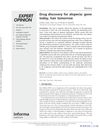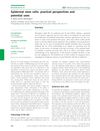TLDR Hair follicle stem cell research has advanced in understanding and using these cells for hair growth and skin repair.
The document discussed the advancements in hair follicle stem cell (HFSC) research, highlighting both basic and clinical progress. In basic science, significant developments included the ability to assay epidermal stem cells in vivo, identify independent interfollicular epidermal stem cells, and analyze individual stem cell divisions. Notably, bioengineered hair follicular unit transplantation (FUT) in mice was a breakthrough. Clinically, stem cells were recognized for their role in wound repair and gene therapy for inherited skin diseases like epidermolysis bullosa. The study of HFSCs advanced with the identification of molecular markers such as keratin 15 (K15) and CD34 in mice, and CD200 in humans, facilitating the isolation and characterization of bulge cells. The paper provided an overview of epidermal stem cells in hair follicles, their characteristics, control of their fate, their role in alopecia, and their application in tissue engineering.
 70 citations
,
February 2015 in “Expert Opinion on Drug Discovery”
70 citations
,
February 2015 in “Expert Opinion on Drug Discovery” Topical drugs and near-infrared light therapy show potential for treating alopecia.
 28 citations
,
November 2008 in “Facial Plastic Surgery”
28 citations
,
November 2008 in “Facial Plastic Surgery” Follicular Unit Transplantation (FUT) can give great results and patient satisfaction when done carefully and by a skilled surgeon.
1 citations
,
March 2022 in “IntechOpen eBooks” Aging reduces skin stem cell function, leading to changes like hair loss and slower wound healing.
36 citations
,
October 2015 in “Cell reports” Gab1 protein is crucial for hair growth and stem cell renewal, and Mapk signaling helps maintain these processes.
28 citations
,
June 2012 in “International Journal of Molecular Medicine” Radiation damages hair stem cells and changes keratin expression, with Krt5 as a potential marker for radiation effects.
 62 citations
,
April 2009 in “British Journal of Dermatology”
62 citations
,
April 2009 in “British Journal of Dermatology” Epidermal stem cells could lead to new treatments for skin and hair disorders.
14 citations
,
April 2008 in “PROTEOMICS” Increased 14-3-3 proteins may block hair cycle regression, causing hair loss.
January 2008 in “Chinese bulletin of Life sciences” Epidermal stem cells help renew skin and regenerate hair follicles.
33 citations
,
July 2007 in “Journal of cell science” Miz1 is essential for proper hair structure and growth.
69 citations
,
May 1997 in “Veterinary Pathology” The angora mouse mutation causes long hair and hair defects due to a gene deletion.



